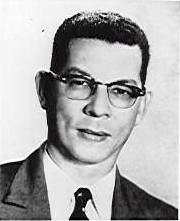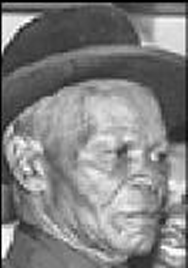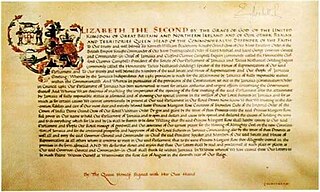Monuments
The Jamaica War Memorial, a cenotaph honoring the Jamaicans killed in combat during World War I and World War II, is a prominent feature of the park. The memorial, which was constructed in 1922, was initially located on Church Street in downtown Kingston, but in 1953 it was moved to its present location. It is topped by a cross weighing one and a half tons. [5]
One of the park's first original monuments was constructed to house the remains of Marcus Garvey. Garvey died on 10 June 1940 in London, but transporting the remains from England was unfeasible at that time due to World War II. As a result, his body was buried in England until 1964, when the government of Jamaica paid to have it transported to the park for a ceremony honoring Garvey as a national hero. Garvey's monument consists of a tomb at the center of a raised platform in the shape of a black star, a symbol often used by Garvey. Behind it, a peaked and angled wall houses a bust of Garvey, which had been added to the park in 1956 and relocated after the construction of the monument. The monument was designed by G. C. Hodges, while the bust was the work of Alvin T. Marriot. [6]
After Donald Sangster died in 1967, Mostyn F. Campbell designed a monument in his honor. The monument consists of an opposed pair of curved members, turning inward and wider at the top than at the novel base. The expansion of the members symbolizes Sangster's development from humble origins, while their separation is meant to suggest the unfinished nature of his life's work. [7]
Another monument was constructed to honor Norman Manley. Designed by H. D. Repole, it was dedicated on 16 September 1972. The monument contains twelve pillars, arranged in two concentric circles, with the inner pillars taller than the outer ones. Each inner pillar is connected to its corresponding outer pillar by a horizontal member, and the inner pillars are also connected partway up by a ring. Manley's tomb is located at the center, topped by a six-pointed star. Each pair of pillars represents an aspect of Manley's life, and Repole's original design called for plaques describing these aspects to be affixed to each pillar assemblage. This plan was not completed, however, due to financial constraints. Instead, sculptures of two human figures were incorporated into the design in 1974. Designed by Christopher Gonzalez, these sculptures depict a male and a female, which are meant to symbolize the birth of a unified nation. [8]
Sir Alexander Bustamante is honored with a memorial completed in October 1979. Designer Errol Alberga created an arch, narrow at the top and widening toward the base, which stands above Bustamante's tomb, finished with marble from the region. [9] Seats are incorporated into the base of the arch, which spans a gap of thirty feet. [10]
Two monuments to historical figures were dedicated on 14 October 1999. The first of these honors Nanny of the Maroons, a female warrior of Asante descent who waged a guerrilla campaign against the British during the First Maroon War. Nanny's monument reproduces the sound of the abeng, a traditional instrument used by the fighters. [11] The second is dedicated to Samuel Sharpe, the leader of the Christmas Uprising (a.k.a. the Baptist War), a slave revolt that took place in 1831. Sharp's monument is shaped like a Greek cross, to honor his Baptist faith, and its corners are left open as a representation of freedom. Both of these monuments were designed by Compass Workshop Limited. [12]
A monument to Michael Manley was dedicated on 15 March 2002. Designed by Mark and Susan Taylor, the monument resembles a graph of exponential growth when viewed from the side. Its surface is covered with slabs of black Jamaican marble, some of which are engraved with quotes by Manley on the subject of equality. [13]
A bust of General Antonio Maceo was added as a donation from the people of Cuba, in recognition of Jamaica having offered him asylum. [14]
The park is also the burial site for 140 elderly women killed in a fire at the Myers Ward of the Eventide Home for the Aged in 1980. A monument marks the mass grave containing the women's remains. [15]












